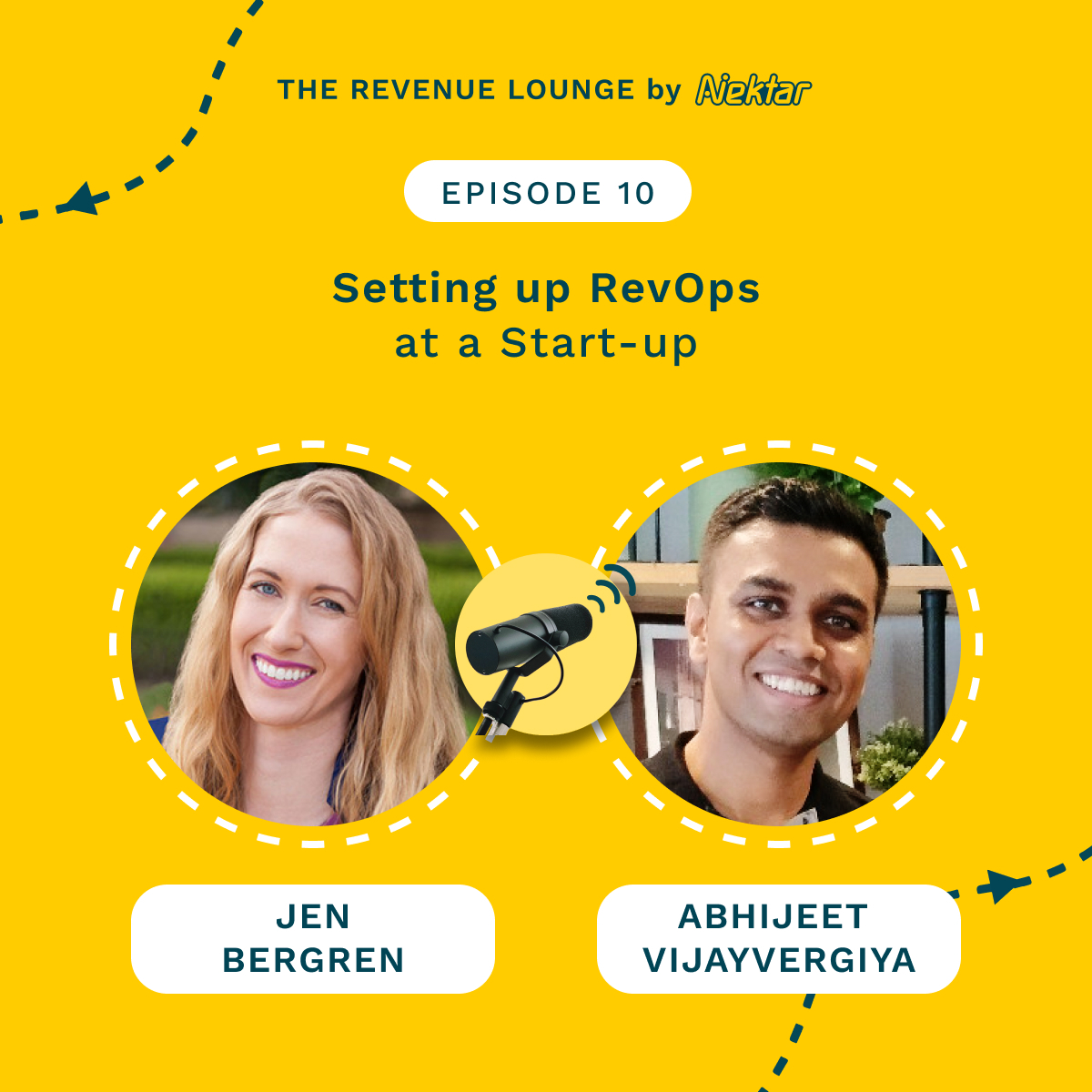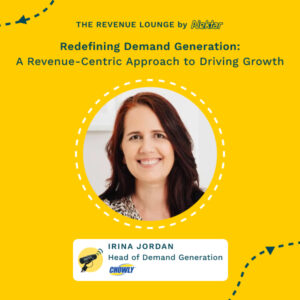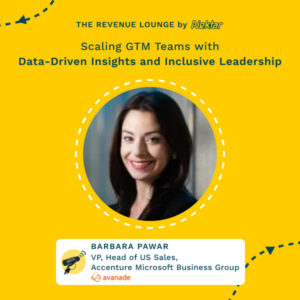Crafting an Effective Governance Framework for Business Applications ft. Bill Vanderwall
December 11, 2024
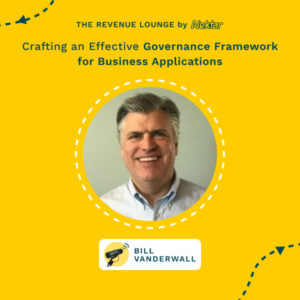
About
The Revenue Lounge
The podcast covers stories from leaders across RevOps, Sales, Customer Success, GTM, Data and Marketing about what drives these functions and what advice they would share with our listeners. With 3 seasons recorded, the podcast currently features 50+ enterprise leaders in the B2B SaaS domain. Tune in to hear from the best in the business
In this episode of the Revenue Lounge Podcast, host Randy Likas and guest Bill VanderWall discuss the increasing reliance on SaaS applications in organizations and the importance of establishing a governance framework to manage these technologies effectively. They explore the role of IT in SaaS management, the buy vs. build decision-making process, and the need for alignment between technology investments and business goals.
The conversation also touches on the challenges of rationalizing SaaS applications, the debate between best of breed and platform solutions, and the implications of AI on legal considerations. Additionally, they discuss the significance of ROI in SaaS decisions, strategies for managing change in governance models, and the critical issue of data quality. The episode concludes with insights on vendor maturity and advice for fostering collaboration between vendors and IT teams.
Key Takeaways:
- Organizations rely heavily on SaaS applications for operations.
- A robust governance framework is essential for effective management.
- IT involvement is crucial to ensure data and process alignment.
- The trend is shifting towards buying SaaS solutions rather than building them.
- Aligning technology investments with business goals is critical for success.
- Rationalizing SaaS applications can lead to cost savings and efficiency.
- Best of breed solutions often outperform integrated platform solutions.
- AI introduces new legal challenges that need to be addressed.
- Vendor-provided ROI should be critically evaluated for accuracy.
- Data lakes are becoming increasingly important for data management.

Randy Likas (00:02.498)
In today’s business landscape, organizations are increasingly reliant on a wide array of SaaS applications to drive operations, enhance productivity, and enable cross-functional collaboration. Go-to-market is filled with these applications, ranging from sales engagement to conversational intelligence to marketing automation to forecasting to customer success. However, with the abundance of technology comes the challenge of managing it effectively. Without a robust governance framework, applications can become siloed, costly, and misaligned with business goals.
ultimately limiting the impact for the organization’s success. Hello, everyone. Welcome to the Revenue Lounge Podcast. I am your host, Randy Likas. In this episode, we will dive into what it takes to build a governance framework that doesn’t just keep IT operations in check, but also aligns technology investments with strategic objectives. And joining me today is Bill Vanderwall. Bill is a VP of business applications with experience at both large and small companies.
He has deep experience with SaaS applications and cross-functional business process solutions, including business intelligence and analytics. His experience lies in aligning technology to business strategy. Bill, thanks so much for joining me today.
Bill VanderWall (01:12.305)
Hi, Randy, it’s great to see you and I’m glad to be here.
Randy Likas (01:15.542)
Yeah. So Bill, I’d like to start these episodes off and just have you give little bit of an introduction. Maybe you can walk us through your background and sort of your career journey.
Bill VanderWall (01:24.827)
Sure, I’ve been working in IT for a long time. started my career at Accenture. I was then Anderson Consulting, and I got an opportunity to go consult at a small company called Netscape, just as it was taking off, and they offered me a job. So I went and I managed Oracle Financials, and then ended up managing all their applications at some point. From there, went to several other Bay Area companies, Williams-Sonoma, Riverbed Technologies. Spent seven years at Marketo.
Randy Likas (01:37.315)
you
Bill VanderWall (01:54.917)
built IT from scratch. They really had no IT when my boss and I got there. We built it and went through a pre-IPO, with private equity and then sale to Adobe. Then went to Malwarebytes where I was in charge of applications and then Sision, which is a large PR marketing and software company.
Randy Likas (02:19.14)
And Bill, you and I were talking about this a little bit in the green room. I’ve been selling SaaS solutions for a long time. what’s kind of been amazing to me is a lot of times, maybe even five years ago, even recently, it’s like two or three years ago, a lot of times the business would buy the software. we wouldn’t have business systems involve much at all. What I’m seeing, though, is a big shift in that. And a lot of the deals that we’re doing now certainly have
IT and business applications represented in those conversations. So we’d love to understand from you what the significance is of building a governance framework and aligning with this trend that we’re seeing for SaaS business applications. How does that framework lay the foundation for impactful decision making and execution?
Bill VanderWall (03:09.905)
Sure. Well, I definitely hear what you’re saying about the proliferation of application, SaaS applications, and it makes the challenging because it is easy to go out and just manage your own if it’s a small enough piece. I would say at two of my companies, both Marketo and Mailrobites where I got there, we had SaaS applications being managed by the business and really needed to step in and provide some IT professional experience, especially as you looked at data and processes that flowed from end to end. So it was really became
very disjointed, the data didn’t flow nice, there’s a lot of manual steps. So having IT involved is great, but we don’t want to slow people down either. that’s where good governance is, can create a balance there. at my last couple of companies, we’ve created a governance structure where we really at the C level on a quarterly basis prioritize the top projects and the top priorities cross-functionally. So everybody at the C level sits there and
know, horse trades between themselves to, you know, kind of fight for the IT resources. And then we go out and tackle things. And if something comes up in a, in one of the business units has wanted to go buy something, you know, sometimes we’ll, you know, we’ll as IT will get involved, we’ll help with the purchase. We may or may not need to be involved in an implementation depending on what it is, but at least we know about it and have, you know, helped select it so that it does flow and end like data and process wise.
Randy Likas (04:36.386)
And so what makes up sort of that governance framework? Like if you think about the different components that kind of make that up, what do you typically have involved in there?
Bill VanderWall (04:44.293)
Yeah, I mean, where it’s been most successful for me is there’s been sort of two levels of governance. There’s been the C level governance. just talked about the quarterly steering committee. so, you know, this worked really well for me at Malwarebytes. Our CFO was really good about, you we had a three year plan, a three year strategy. He was really good about letting the senior leadership team know what that looked like. And then from there we went into an annual operating plan. And so that was used to kind of govern how much money we were going to spend.
But then how to use that money was where it became interesting. And that’s where the C-level executive committee just sort of said, here’s our top priorities for this year. Here’s what we want you guys to focus on. You tell us how to best apply your resources to help us with the systems piece of it. And so we would go back and forth. every once in while, fortunately, I’ve been in places where it’s been very collaborative at the C-level, where the C-levels
generally agrees like, yes, that’s a priority right now. We’ve got to increase retention. So, you we’ve got to really focus on our customer success software, for example, you know, so, so there hasn’t been too much, you know, fighting. There’s been alignment at like what’s really most important for the company. And then we can align around that. But then, so that’s the top level, but one level below that often I’ve had operating committees and those meet on more of a monthly basis. So that’s how like, how are the projects doing?
Are there things that don’t need to go to the C level for approval that we just need to just go get them done? And some of those became.
Bill VanderWall (09:36.961)
Ready.
Randy Likas (09:38.82)
Okay, yeah, that was weird because usually it’ll pause, but this time you just dropped off the call completely.
Bill VanderWall (09:43.143)
My I got a blue screen of death. PC is shut right down. So sorry.
Randy Likas (09:49.488)
is that right? Okay. Where we left off, you had started to give the gong example. That’s kind where we left off.
Bill VanderWall (09:54.729)
OK, so.
So for example, know, if a, well, I’ll just start back with operational committee. So we have an operational committee we meet like on to go over project status and we go over lower priority things that don’t need C level approval. For instance, like if we went out and the business wanted to get gone, some sort of plug into Salesforce, that didn’t take much IT resources, you know, maybe a little bit, but you know, what we would do is we would help with the selection.
so that we’d make sure like this fits within our overall architecture and that it will sink and then we’ll give an estimate for how much it will take to actually set it up. But then we can go and set that up and then the business can go administer it, like that’s fine. So we would have an operational level committee that we had on a monthly basis to go over enhancements, smaller priorities, smaller projects, things that didn’t necessarily need to go to the C level.
Randy Likas (10:53.572)
Got it. Okay. And then oftentimes we’ll hear, and it used to be much more sort of many years ago, but the whole buy versus build decision comes up quite often. Typically, where is that? Is that involved in the strategic level or is that more at the operational level? And how does a buy versus build decision, what are the different factors you think about when you decide that?
Bill VanderWall (11:16.533)
Yeah, I think that the landscape has tipped quite a bit towards buy over the last 10 years, just because there are so many point solutions that plug into your bigger platforms like a Salesforce or a NetSuite or something like that. so the cost to build something now, if there’s another group who’s investing in R &D to make it successful is really, I mean, it really makes more sense to…
by these days. are still instances, especially in engineering or product led companies where, you know, the engineering groups might want to go build something. And then it is a strategic decision, usually, you know, between the CIO and the CTO that’s sort of figuring out like, where does it make sense? You know, where, where I come down is, you know, if it’s generally something that needs to be a core competency of the business and part of their product strategy, then it makes sense to build. But otherwise, if it’s building, it’s serving a
business operations function, really makes sense to buy these days.
Randy Likas (12:17.464)
Yeah. Where does the alignment with the overall strategic goals of the company or the business outcomes, where does that typically come up? Is that at both levels or is it more at the operational level?
Bill VanderWall (12:32.363)
both levels, but I would say that’s a steering level steering committee level conversation, just to say like, you know, you know, where like I talked about malware bytes where it was pretty successful, you know, we did have like strategic goals for the for the year we had five, you know, our five top goals for the year as a company and that our, our annual operating plan, our AOP was built around that. And so, you know, those are the things that we had aligned around. And we would say that like, we need to get our retention from X to Y and
you know, we would build a strategy that included both process and systems to try to get us there. And it was really at that level where we’re going to, we’ll be measuring the outcomes here. We’ll be looking at what our retention is, our gross retention, our net retention, and we’ll see if we made our goals or not.
Randy Likas (13:16.162)
Yeah. In the green room, we talked a little bit about this. earlier in your career, think there was an environment where you’ve had this sort of really chaotic list of just IT demands and too many projects and not enough resources, right? For other folks who might be in a similar situation, what are some practical advice you would give them in terms of setting up a governance model like you described?
Bill VanderWall (13:41.609)
Yeah, when I got to RiverBit technology, is many years ago now, but when I got there, there was a list of about 270 items that they wanted the IT applications group to tackle. they were just, so it was like a laundry list. they’re like, no sizing, everything from like change of field on a report to overhaul configure price quotes. Everything was like all each one level on an Excel spreadsheet. So what we really did is we
triaged it. So first of all, we just did some rough grouping and sizing, said, basically, what are the themes that we’re going after? Is this revenue driving? Is this efficiency? this kind of what category did this fall on? Can we group some of these together and make them into a project or a program? And then can we sort of t-shirt size it in terms of effort? And then outcome, like impact. So we
did that first, we brought that back to, we created the executive steering committee because it didn’t exist when I got there. We went back to that group, said, here’s what we think our priorities are based on what we’ve heard from you. Is this right? And then we tweak and then come up with our plan. And so we had our priorities, we had our plan, we had things sort of organized into kind of workable chunks and we went forward from there.
Randy Likas (15:01.87)
Bill, I want to ask you question about, so I have a strategic account that I’ve been focusing in for a while and they hired a new CEO a couple of quarters ago and the last earnings call, he made a really interesting statement. said, I think we went through a period where we bought basically, if there was a SaaS application out there, we bought it. And in the spirit of trying to get more efficient operationally and save on some investment costs.
Bill VanderWall (15:21.313)
You
Randy Likas (15:31.586)
He really wanted to align and he was leaning on his business systems team to think through what’s critical to the business versus nice to have. Curious kind of like, what’s the process that you kind of walk through if you’re in a similar situation and you’ve got just all these different applications? How do you work with your internal stakeholders to say, you bought this for a reason because you thought you’d probably solve this problem, right? But we’ve just got way too much sprawl across this. kind of need to scale it back. What does that conversation look like with the internal stakeholders?
Bill VanderWall (16:01.429)
Yeah, mean, having a lot of applications isn’t necessarily in itself bad. mean, one of my old coworkers used to say it’s like your phone. It’s like, now that you have an iPhone, you put on a bunch of other applications and some of them work and some of them don’t. Now, you have to pay for mostly. there is a financial conversation here, but typically on at least an annual basis,
usually maybe like a twice annual basis. In my past few companies, what we’ve done is we’ve tried to rationalize that list and just come up with like, who’s using, what’s the list? How much are we spending? And then we’ve had some tools at my last couple of companies where we’ve actually like able to dive into usage, like actual usage to say like, how many people are really using this? Are they logging in? And then we try to be ahead of renewal cycles on these things.
You can sort of say like, okay, we’ve got three of these and they kind of do the same thing, but they’re not exactly the same. Can we rationalize to one? At Marketo, I had four survey tools. And so we said, can we, it doesn’t make sense or do we want one survey tool that everybody aligns around? And we ended up doing that. We ended up going to one, although it was a top end tool and it was a little more expensive. So there were like,
a few things that we just kind of said, okay, you can still use a cheaper solution for that. But really our strategy is to build our expertise around this tool. And so it’s usually a once, twice a year conversation to really rationalize spend and to measure usage.
Randy Likas (17:43.118)
Yeah. So Bill, there’s a really interesting trend in go-to-market software right now where a lot of what I would call companies that started out building a single product have been, whether be sales engagement or conversational intelligence or forecasting, whatever it might be, and there’s been this big rush over the past, I say, 18 months to build each other’s capabilities and develop for that platform solution.
Bill VanderWall (18:06.795)
Yes.
Randy Likas (18:11.916)
I understand the reason for that because companies want to consolidate costs and if they can get a platform solution that does a lot, that makes a lot of sense. Yet, I think a lot of times what the company did first is typically what they’re best at, right? as they’ve rushed to of build these platforms, they’re not necessarily best of breed. And so I’m just curious, what’s your perspective on that as far as looking at a platform tool as opposed to going best of breed? How do you think about that?
Bill VanderWall (18:41.727)
Yeah, I’m generally lean towards best of breed for that reason that you just said, like, you know, they are trying to all expand their space, but they do one particular thing. Well, you know, I’m most familiar with applications that plug into Salesforce. And so, you know, as long as it plugs into Salesforce, you can generally do best of breed because it still communicates with sort of the, you know, the mothership Salesforce platform. But, you know, there, there have been instances where, you know, it,
it gets close enough and then there’s like a efficiency of scale. It’s just like easier to maintain, it costs less. And so that tipping point is again, something, you know, hopefully six months before renewal, talking about doing demos to see, okay, have they come far enough with conversational intelligence or whatever they’re trying to do, AI features, whatever they’re trying to do, have they come far enough along that now we can move to
one solution and rationalize or do we still want to keep our best of breed? And in most cases I’ve seen keeping best of breed, but I have seen it go the other way a few times.
Randy Likas (19:47.588)
Yeah, for sure. Especially with budgets tightening up and everything else. It certainly is a consideration, but I think it just sort of depends on the company. You mentioned AI. AI certainly, I mean, everybody’s talking about it. Everybody’s building it into their products. Everybody’s excited about it. We often find, though, that when things get to legal, there’s a lot of concern right now around AI right now.
To what degree is the business systems team involved in those conversations to help legal understand risks and or best practices that guide sort of the questions that they push back in like a contract?
Bill VanderWall (20:28.213)
Yeah, it’s really, it’s two things. One is working with legal and secondly, it’s working with the vendor to understand, okay, what are you going to do with our data? We understand that you want to try to use our data to train your models. To what extent do we lose control of our data if we turn it over to you in that situation? And so I’ve had back and forth with between legal and the vendor where they’ve come to terms and say, like, okay, this is acceptable usage of our data, you know, either through
you trying to isolate it or, you know, make it more anonymous or, know, but there is a, that is a back and forth and there are valid concerns right now about, you know, letting companies have access to your data in a way that, you know, could jeopardize your own security around that data. So it’s, it’s, this is a conversation that, that, that needs to happen right now, but it’s not black and white. you know, legal,
definitely wants to sometimes or risk wants to shut everything down. But there are some uses that are very valid and man makes sense. So it’s just, it’s a conversation.
Randy Likas (21:37.666)
Yeah. Any advice that you might give, for people that are kind of going into those conversations, how to sort of bridge that conversation between the vendor and legal, that best practices or ways in which you could make it a little bit less friction?
Bill VanderWall (21:54.197)
Yeah, best practices is try to get those two groups on the phone together at the same time. Cause I’ve had it where it’s gone back and forth for, you know, for a few weeks where, know, both, both, know, vendor and legal are sort of dug in, but then we, you know, do a phone call, get the right sales engineers on the line, you know, go over things and come up with a sort of reasonable compromise. So it’s really a brokering a meeting. I think the challenge is getting somebody in.
Randy Likas (21:59.203)
Yeah.
Bill VanderWall (22:22.837)
legal at risk who can understand the technology well enough to really feel comfortable with like what they’re doing with the data. So, but in my last company, were definitely people in legal insecurity who had those skills. So that was helpful.
Randy Likas (22:39.62)
Yeah. Getting back to the governance framework for a moment, I’m curious, when you think about things that SaaS applications that people are looking to buy, whether they’re departmental or whether they’re cross-departmental, and the stakeholders that it’s impacting, where does that play in the framework? Obviously, if it’s going to impact more departments, it might be a little bit more strategic.
I’m just curious, where does that fall within the framework? Is that a component of the framework in terms of overall organizational impact? And probably the more departments it involves, the more impact it’s going to have.
Bill VanderWall (23:19.579)
It is part of the framework and it’s part of both this, often it can be below the C level steering level where some of these things come up, but that operational level, trying to have more participants across the organization is pretty key. Cause it was just me and the controller and the VP of RobOps. Like we cover like 80%, but then often, especially when you get into things like project management tools where like engineering has one, marketing has one.
they’re potentially different. So I think getting together and just trying to have representatives from each of those functional units in your operational committee, it’s pretty important to hear about those things. And then to ask the question, like, okay, if these guys are using Asana, these guys are using Monday, can you both use the same thing or can’t you? And then it’s another sort of software vendor evaluation to say like, yes, we can or no, that doesn’t make any sense for us. These guys have a marketing calendar or these guys,
integrate with JIRA so you need them in products. So, you know, it’s those kinds of conversations just to try to justify. it’s okay to have multiple if it’s justified, but that’s exercise of trying to justify. And then just to listen and learn like what’s happening in the rest of the organization so things don’t get too siloed.
Randy Likas (24:28.569)
Mm-hmm.
Randy Likas (24:37.282)
Yeah. What role does ROI play in the decision? Because vendors always paint a rosy picture in terms of what their ROI could be. And you actually kind of need to understand, you can’t have a generic ROI model. It’s got to be custom there. So curious to kind of get your input on what you think of vendor-provided ROI. And if you do some things differently, how do you build that case?
Bill VanderWall (24:45.451)
Hehehehe
Randy Likas (25:06.237)
internally and how is it different than maybe what the vendor provides.
Bill VanderWall (25:10.421)
Yeah, vendor provided ROIs just they’re good directionally. And often that, I’ve done work with vendors who’ve had business value teams have come in and really have like understood the right kind of value that you’re providing. Like, know, like, yes, we’re really going to streamline billing. It’s going to do these three things. It’s going to eliminate some of this manual effort to get to the ROIs tougher. There is often a lot of soft dollars in there.
And so, you know, I think you just need to take a look at what dollars are hard, what dollars are soft, how much of a fudge factor do we attribute to those soft dollars? And then trying to say at the gut, is this worth it? You know, I mean, I think, you when I was at some of the tech companies that I’ve been at, definitely operate more by a little bit more by feel, even at the executive level versus needing to see a hard dollar ROI. At some other companies, they’ve had to see that hard.
dollar ROI and that’s been tougher to get projects going and often, you know, some strategic projects just don’t get done because it’s too hard to prove the ROI upfront. So, you know, I think it’s, all about like how much budget really is it consuming and how much risk does a company want to take, you know, because they don’t always work out.
Randy Likas (26:31.842)
Yeah. What are your thoughts on like, you know, lot of the analyst firms, Gartner, Forrester have their sort of own spin on it, Gartner’s is total cost of ownership. Forrester’s is total economic impact where they sort of build like a composite organization and look at the benefits and sort of build that out. Is that any better than a vendor provided ROI?
Bill VanderWall (26:50.305)
I think the vendor provider ROIs get a lot more specific in terms of, you know, because often they’ll apply resources to really help understand like what’s the specific business problem we’re trying to solve in your instance. You know, things like total cost of ownership are great and good considerations, but also time to value is, you know, really critical too, because
if we’re really looking at something that’s going to drive efficiency or drive revenue, we want it to get it pretty quickly. so, and if it comes to fruition and drives revenue, then that takes care of total cost of ownership in the long run. one of my leaders at one of my last companies, there’s just like a little bit of revenue growth can go a long way to cover a lot of expenses. So, you really got to focus on time to value and what’s it really bringing to the organization.
Randy Likas (27:48.068)
Yeah. Thinking back to the organizations that you worked at that didn’t necessarily have a governance model in place, and you’re introducing a concept like this, there’s a lot of change that sort of goes into that, right? They probably didn’t, weren’t told no a whole lot. And now we’re saying, look, we have to have some more structure. So I’d love to get your perspective in terms of how to manage that change and what are maybe some practical or tactical.
recommendations you would give in terms of how do you manage different stakeholders, both at the executive level and think at the operational level, to say, no, this is the way that we’re going to be looking at things now, and it’s not like it used to be.
Bill VanderWall (28:29.001)
Yeah, mean, quick wins are important to build some trust. If you’re introducing a new governance model, like, well, why should I trust these guys instead of just go do it myself? some quick wins are important, especially take a look at data flow, fixing some data flow problems, fixing some process flow problems, giving the organization capabilities they didn’t have. Those are important in building trust.
We like in my past, we try not to be too heavy handed to draconian, just like, you know, at Marketo, there was a, you know, there was a different group who managed some of the support things and, know, we sort of let them be on their own for, for a long time because they were, they were good at communicating with my team and they were, but they were pretty efficient and they were, you know, very focused on
on the solutions. so we just said, like, we’re not going to force you guys to come be part of IT, but we definitely want that communication line to be open. We want to be planning together. And it actually ended up being a pretty good partnership. And it wasn’t, you know, it wasn’t a lot of infighting in politics. It was more like we, have the same objective and we have to be on the same page, but it doesn’t matter if it sits in your work, sits in my work. So I think those are a couple ways to manage the changes. Don’t be too
you know, to black and white and build trust and build wins.
Randy Likas (29:58.072)
Yeah. I want to pivot the conversation a little bit, not so much on governance framework, but something we see very often, which is data quality. every organization we speak with always has a data quality issue to some degree. And I’m speaking more in the sense of customer data, like Salesforce and things like that. And it amazes me how people just learn to live with bad data because they operate the business anyway.
What role does business systems play in improving data quality? there somebody on your team that’s kind of responsible for that? And you would just love to get your perspective in terms of like why people aren’t necessarily, why data quality isn’t higher on the list as opposed to just sort of learning to live with it.
Bill VanderWall (30:47.745)
yeah, I mean, it’s, it’s hard. That’s why, you know, it’s, it’s, it’s hard and it’s can be like, depending on how you design it, like it can be time consuming. And, you know, if you make an SDR search for an account before they create one, is it really going to slow them down? Like, can you, can you provide tools to provide better data governance? you know, or is it really going to, you know, become, you know, more effort for not much gain. So.
Randy Likas (30:52.228)
you
Bill VanderWall (31:17.853)
I think you have to really figure out what are the important things that you have to build sort of on the front end and build processes and governance around versus the, know, okay, maybe that can be a little messy. They maybe that’s okay. you know, when I was at Malwarebytes, we had a lot of data quality problems and we fixed some in Salesforce. We fixed them in the processes. We, you know, we definitely did some work with in tandem with rev ops where we, you know, let’s, let’s
have Zoom info help us and really kind of cleanse some of this data, harmonize it. You we can use solutions to eliminate duplicates. We can, you know, kind of merge things and that worked. But then ultimately we also created a data warehouse and we did some transformations in the data warehouse so that that was another way to improve the data through.
as we sort of reported it out, sometimes we would loop some of those changes back into the source systems, but sometimes we wouldn’t, and it depended on how important was it, or how easily could we harmonize it in the data lake and in the reporting layers.
Randy Likas (32:18.116)
Yeah, that’s definitely something we’re seeing as well is focus less on it being in the CRM. If we can put it in the data lake, we can solve a lot of problems. And certainly, I think a trend that we’re seeing more more companies leaning into, which is making sure we can get it into Snowflake or whatever application that they use. Is that something that you see, if you think maybe the next 12, 24 months, how important is the data lake, you think, in the next couple of years? And will more companies be moving in that direction?
Bill VanderWall (32:45.949)
I’d expect so. mean, it was, it was really, transformational when I was at Malwarebytes and at decision, it was pretty transformational too. It really can provide a lot of insight that it’s hard to get out of, out of a Salesforce, you know, reporting layer. So, and cause you can just marry it with all kinds of other data. and it’s easy to transform with there’s tools that make it easy to do transformations and it really can be.
Randy Likas (33:06.85)
Yep. Yep.
Bill VanderWall (33:15.339)
transformative and it allowed us at Malwarebytes, it allowed us to get to a bunch of business SaaS metrics that we just didn’t have before we put in our data lake. So it was really powerful.
Randy Likas (33:25.848)
Yeah. A lot of companies right now are building data share components to be able to share the data over. And some companies are actually starting to build snowflake native apps. What are your thoughts on that? Is there a bunch of a preference or an advantage to one over the other?
Bill VanderWall (33:43.329)
It’s really interesting because, know, at my last company, we had several Salesforce instances and we needed to harmonize a bunch of data across the instances. And, you know, there was some architectural decisions to make to say, do we do this in the data lake and use our own transformations? Or do we start to rely on vendors who are now sort of coming up with their own harmonization schemes, especially using AI and other external data?
I would say that we weren’t quite far enough along to really come to a conclusion there. So we were just evaluating, one of the tools that we used to try to harmonize some of the data in the backend was from a company that ended up then going out of business. I think it’s really an evolving space right now, but there’s a lot of promise in this space. So again, I think it’s just an analysis, like what should we do on our own? And this is a good builder by conversation because it’s not, there’s not a ton of
ready-made solutions out there yet, but they’re coming.
Randy Likas (34:42.136)
Yeah. Yeah. You bring up an interesting point, is newer vendors who are maybe doing some really innovative things and want to bring that into the business first, more established vendors who have been around a while. So there’s risk, right? They could go out of business. We’d love to hear your perspective in terms of how is vendor maturity, if you will, how established they are, how important is that? And does that actually feed into the government’s framework as well?
Bill VanderWall (35:10.777)
Yes, it does. And we had a software selection process at a couple of companies that I worked with that was definitely one of the considerations is like we, you know, we did like how long have they been in business? What was their executive team look like? many, what was their company and revenues? You know, what’s their, do we, you know, ran a D and B check on them. You know, that was part of the selection model to say like, are these guys mature or are they just working out of their garage?
And that did make a difference to us in what we selected.
Randy Likas (35:38.894)
Right. Yeah.
Yeah, like if there was a really, really cool technology that solved the problem that they didn’t have, but they were young in their career, like would you give them a chance or is that too much risk to actually take on for a large business like Decision?
Bill VanderWall (35:54.849)
depends on the solution and how critical the solution is. would say it’s probably, if it’s really critical to revenue generation and to our own numbers as a company, then I would say it’s too risky. But if it’s an area where it provides some efficiencies or some, maybe it’s an area where you can take a little risk. It just depends what it, it really depends what the solution is.
Randy Likas (36:22.946)
Yeah, so if I play that back to you, it’s like if it’s mission critical to the business, we’re gonna be a little bit too much risk. But if it’s something a little bit more tangential that could provide some efficiencies or some benefits, it might be worth exploring. it kinda replaying? Yeah, yeah. Fantastic. Bill, let’s transition the conversation to what we call the lightning round, which is a little bit less professional and a little bit more personal. as somebody who has sort of grown up consulting world,
Bill VanderWall (36:33.853)
Exactly. Yeah, exactly.
Bill VanderWall (36:42.315)
Okay.
Randy Likas (36:50.954)
you know, built IT organizations and now being, you know, sort head of business systems. What do you really like about your job? Like, what’s your favorite part of your job?
Bill VanderWall (37:01.409)
I love seeing teams grow. I love seeing people get confidence in what they’re doing. You know, so I’m a big believer in situational leadership. Like sometimes if folks, you know, are just learning something, you know, I may need to lean in and really help them. But if they’re competent, but then maybe not confident.
like that’s a place where, you know, just trying to build up that confidence so they can just go and take off in their careers that, you know, I love to see that. I’d love to see people who grow in their confidence there, you know, get a couple of wins under their belt and really build their partnerships with the business and then start to really, really provide value.
Randy Likas (37:40.77)
Now Bill, there’s always a flip side to that question, which is that least favorite part, or set a different way. Like what’s really, really hard about your role?
Bill VanderWall (37:44.193)
You
Bill VanderWall (37:48.277)
You know, sometimes you have to tell people no or tell people to wait. This is part of the governance. Like part of the governance is there’s people who just don’t get and that can be really frustrating to some of the business groups. And it can lead to some groups just saying, okay, well, we’re just going to go by ourselves. Hopefully there’s some enforcement at sea level governance level to say like, well, that’s not really the spirit of this governance. Like you can’t just go out do your own thing. Cause then we’ll just, you know, we’ll prove it as an IT project. Then we’ll go out and work together on it.
Randy Likas (38:12.036)
you
Bill VanderWall (38:17.537)
But you’re telling people to wait as hard. We’ve had a couple of times in my career where, you know, there’s groups that like, like an HR group or legal group who just like, Hey, we’re never going to compete for those dollars based on like revenue generation, but it’s what we do is important. And so we’ve allocated budget and we just said, okay, we’re not going to put you through all the governance hurdles. We’re going to give you X budget per year to spend on systems as long as you live within that.
you know, you’re, we’re going to just going to give you a piece of it you don’t have to fight for it.
Randy Likas (38:53.016)
Yeah. So for those instances where organizations or stakeholders say, I’m just going to go buy it myself. If it requires the tie into existing systems, you still kind of have veto power, right?
Bill VanderWall (39:03.089)
Yeah, right. Well, yes, but if they’ve already signed the contract, you have to go, yeah, mean, you gotta go do it. But that is a case where it’s like that feedback loop to, and I’ve had some of those instances where there’s been conversations back with that Civo to say like, hey, that’s not really the way that we wanna do these things. Like we wanna be a part, please just invite us upfront. We wanna be part of that selection. We wanna make sure it fits and…
We do want to make sure that it’s really a priority. Like if it’s really a priority, you know, then we’ll go do it. But we need to, sometimes it’s been some of those conversations like, okay, we understand why you went and did that, but please next time go through the proper cycle. Be a good corporate citizen.
Randy Likas (39:47.483)
Yeah.
Randy Likas (39:53.577)
So with the hindsight experience, know, hindsight’s 20-20 and, you know, what advice would you give to maybe your younger self as you’ve kind of grown in your career?
Bill VanderWall (40:04.449)
Yeah, I would say to one is to listen, just, you know, be a good listener. And then two is, you really work hard to develop cross functional relationships. Like that’s, you know, really the key is to, and it’s become harder in a remote environment, you know, where we’re more remote, we’re more hybrid, we’re less in the office. It’s more important to really sort of
make sure you have some proactive time with the business partners and really try to build those operational committees that aren’t as organic when you’re not sitting in the same place.
Randy Likas (40:43.492)
For those who are maybe thinking about building a more structured, rigorous governance framework, what advice would you give them to sort of turn to for inspiration or ideas? Like, you know, maybe analyst firms, maybe there’s some books that you’d recommend. Just curious, if there’s any resources that you might, you know, leave the audience with as we wrap up the episode.
Bill VanderWall (41:07.989)
That’s a good question. I mean, think a lot of it is just common sense. just like, mean, part of it is it’s trying to go from what IT is often viewed as a cost center and we really want it to be business partners. So I think, you know, part of building that governance is just to say like, look, you guys are the, you guys are in charge of turning up and down the levers of spending.
that control like what we can deliver, but we want to be the best business partners we can be. We don’t want to just be a call center. We really want to understand like, what are your business objectives? We want to be involved in those conversations upfront. you know, don’t come to us with a solution design already in place. Come to us with like, what business problem are you trying to tackle? You know, involve us upfront as business partners. Let us help develop the design for the solution. Go pick the solutions. And I think that’s a much more successful way.
you know, it’s just, and so part of that is just building the skills to do really good business analysis and have good like on in IT having people who really can understand the business concepts that aren’t just, you know, technicians.
Randy Likas (42:19.672)
Yeah. Last question I have for you is any advice you’d give to the vendor world, right? So in using the example I talked about before where a lot of times apps were being purchased and not having to have IT involvement, businesses buying them. And as IT is getting involved, think a lot of times people will sort of, the hair on their neck will start to raise up. be like, I thought I had this deal done and IT is going to come in and muddy the waters for us here. But…
But I think that’s sort of a negative way of looking at things. think IT can actually be, if you can proactively reach out to them and partner with them on things, it might actually be, you know, help you. So I just love to understand, like, what advice might you give to the vendor world who’s maybe selling to the business, but how can they partner better and more closely with IT?
Bill VanderWall (43:03.989)
Yeah, I mean, the low code, no code stuff is brilliant these days. I mean, I do love to have applications where the business can just go operate it. Like I don’t have to be involved in everything you’re doing as long as I understand like, what are your inputs? What are your outputs? You know, does it connect in a way that makes sense with our overall architecture? But I just, I love it when, you know, marketing ops team can go and do their own stuff and don’t need me involved. That’s awesome. Like, so.
Randy Likas (43:17.932)
Yeah. Yeah.
Randy Likas (43:31.981)
Yeah.
Bill VanderWall (43:32.321)
I would just say continue to invest in ways to make that easy from a low code, no code standpoint.
Randy Likas (43:40.472)
Yeah, great advice. Well, that’s a wrap. think we’re getting close on time. So Bill, I just want to say thank you very much. We have a lot of marketing sales and success leaders on this podcast, but I think you brought a really interesting perspective to this call that our audience is going to really enjoy. So thank you so much. That’s it for the Revenue Lounge. Look forward to speaking with everybody next time. So have a great day.
Bill VanderWall (44:02.187)
Thanks, Randy.

Ep #1: Navigating the Downturn with a Hyperfocus on Productivity
Listen Now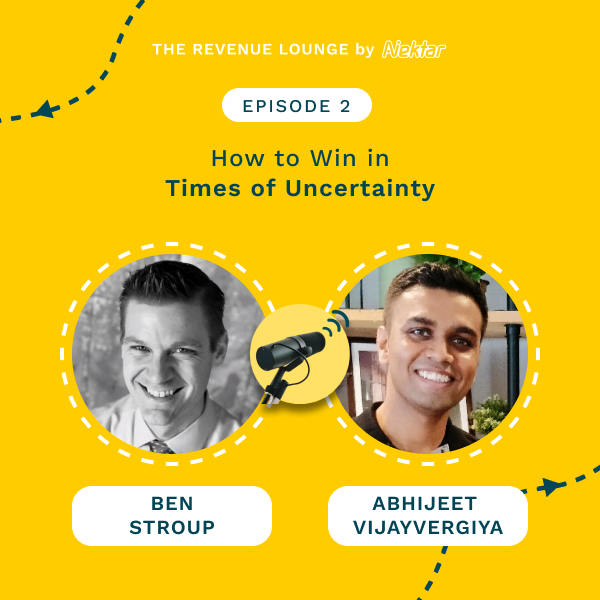
Ep #2: How to Win in Times of Uncertainty
Listen Now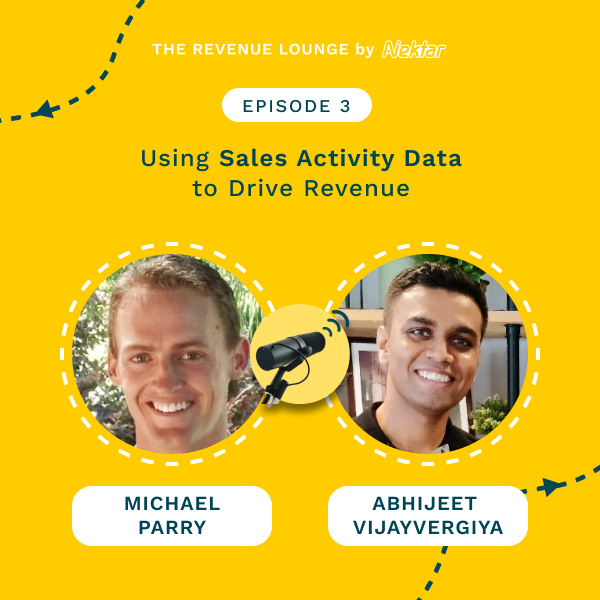
Ep #3: Using Activity Data to Drive Sales Productivity
Listen Now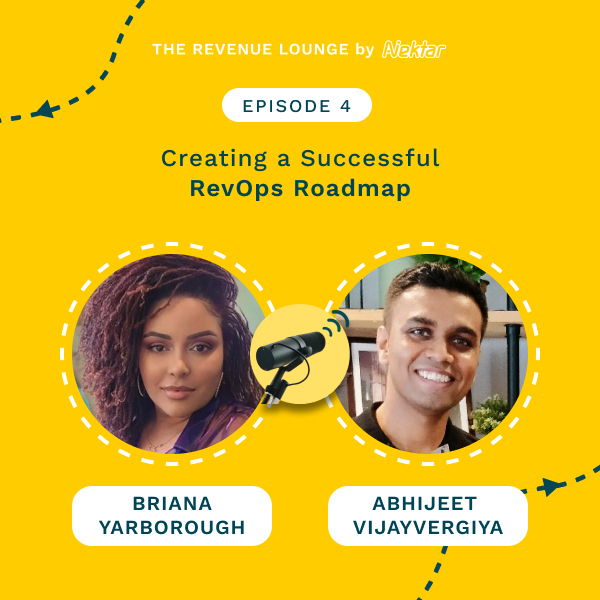
Ep #4: Creating a Successful RevOps Roadmap
Listen Now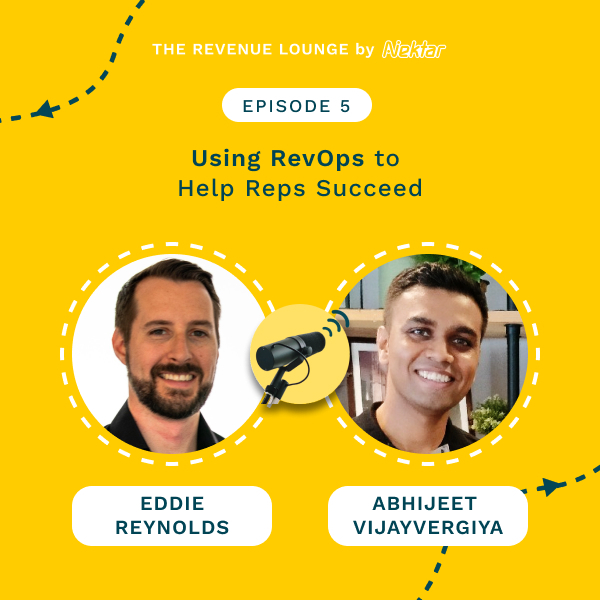
Ep #5: Using RevOps to Help Reps Succeed
Listen Now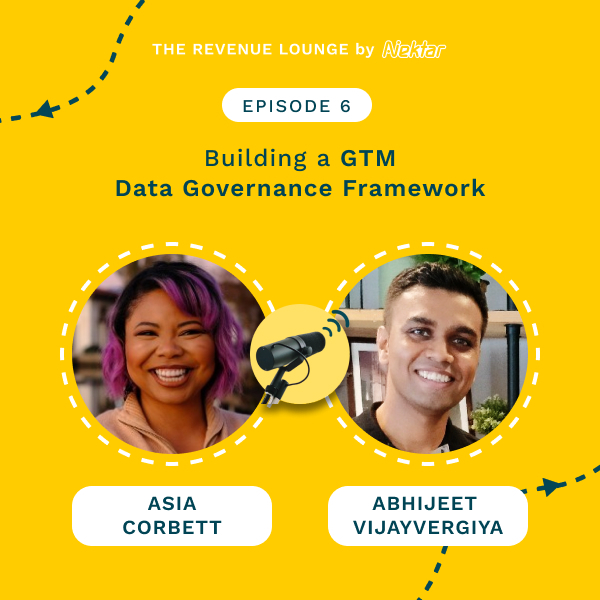
Ep #6: Building a GTM Data Governance Framework
Listen Now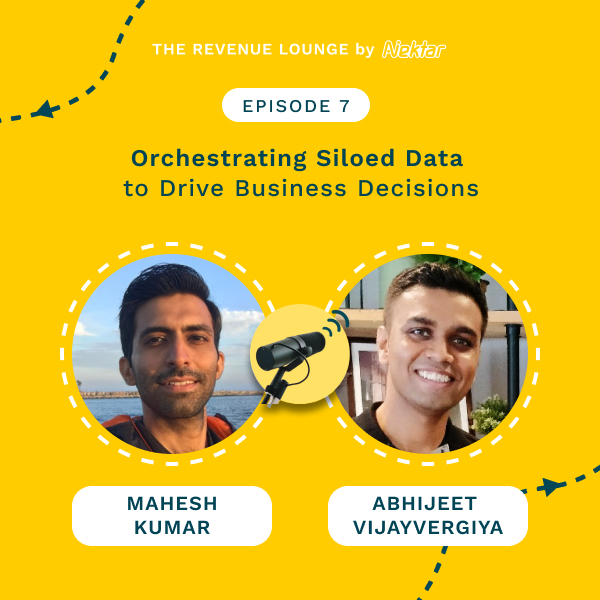
Ep #7: Orchestrating Siloed Data to Drive Business Decisions
Listen Now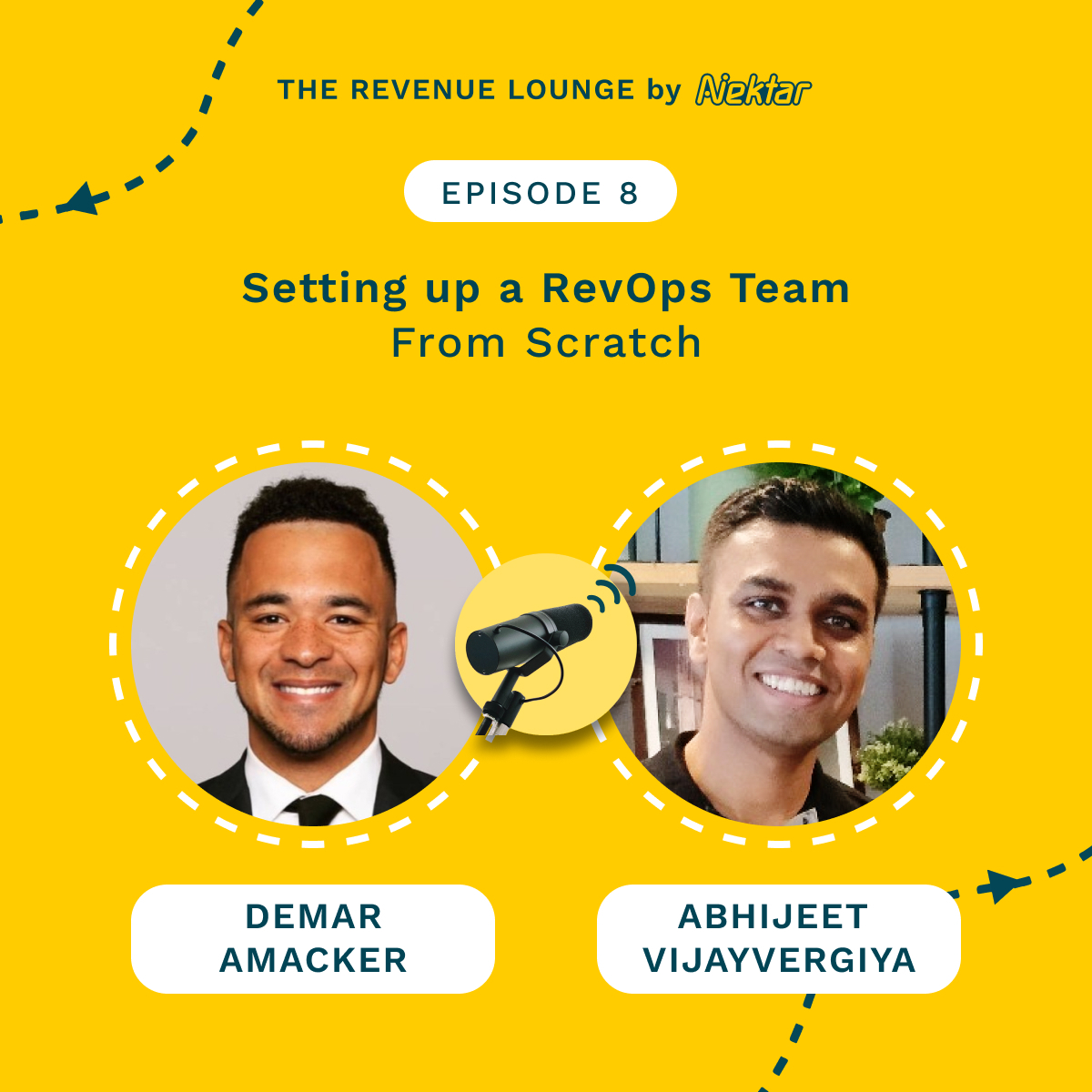
Ep #8: Setting Up a RevOps Team From Scratch
Listen Now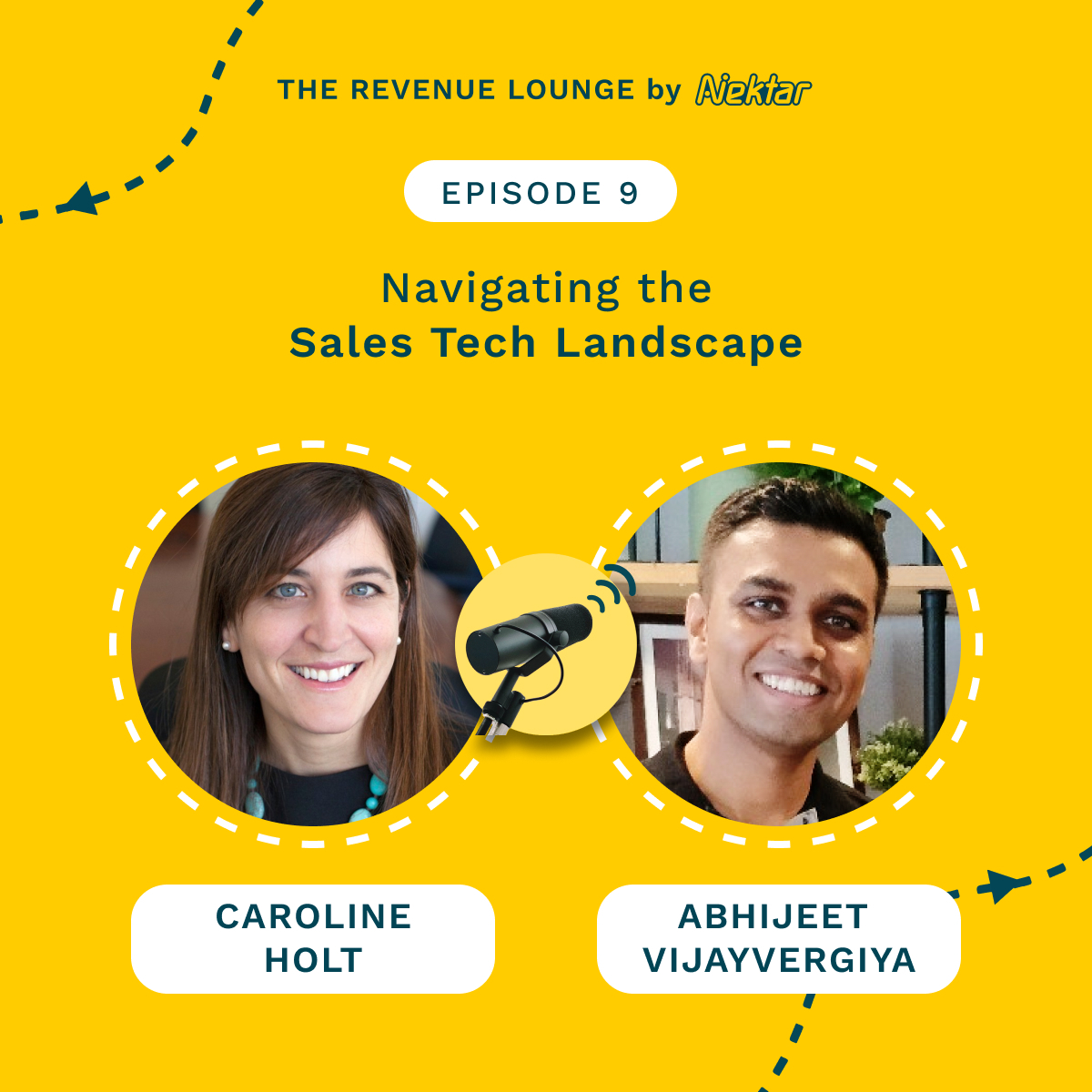
Ep #9: Navigating the Sales Tech Landscape
Listen Now